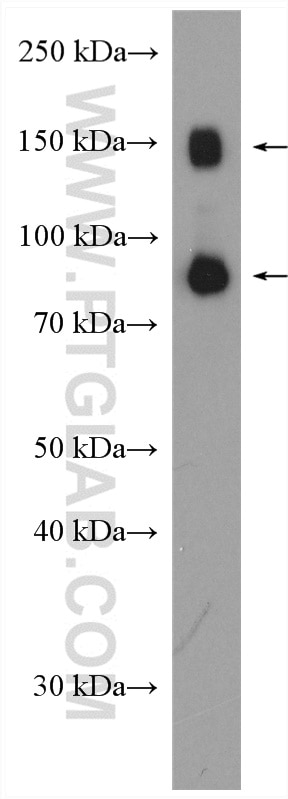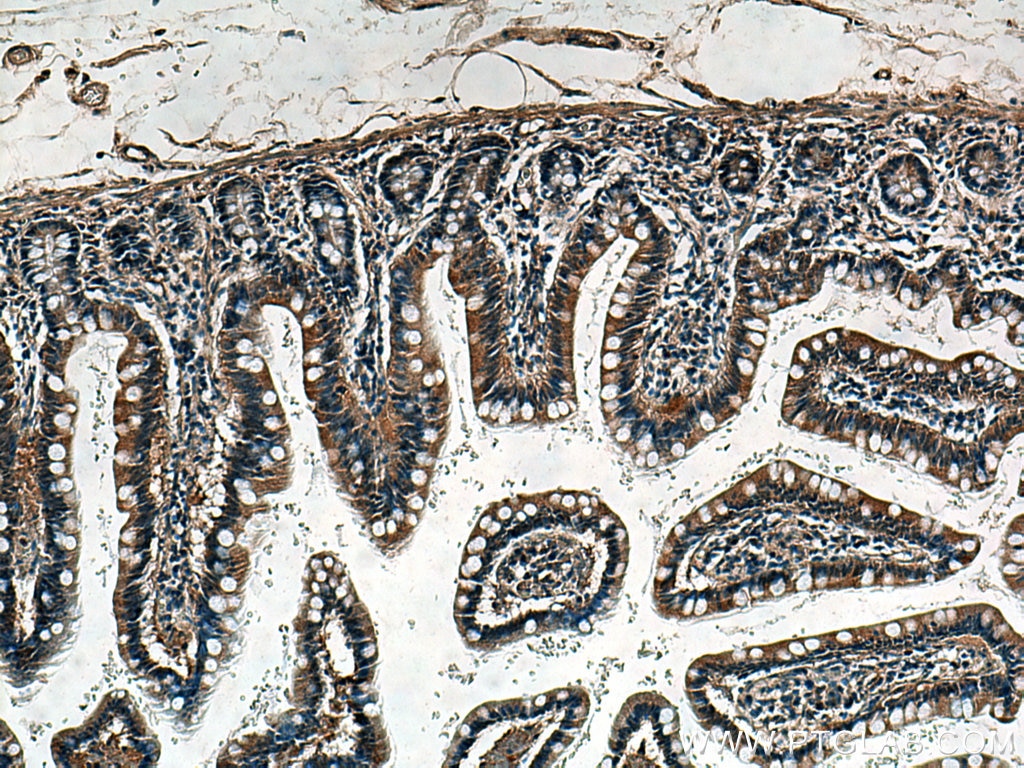- Featured Product
- KD/KO Validated
TRPM5 Polyklonaler Antikörper
TRPM5 Polyklonal Antikörper für WB, IHC, IF, FC (Intra), ELISA
Wirt / Isotyp
Kaninchen / IgG
Getestete Reaktivität
human, Maus, Ratte
Anwendung
WB, IHC, IF, FC (Intra), ELISA
Konjugation
Unkonjugiert
Kat-Nr. : 18027-1-AP
Synonyme
Geprüfte Anwendungen
| Erfolgreiche Detektion in WB | Mauslebergewebe |
| Erfolgreiche Detektion in IHC | humanes Dünndarmgewebe Hinweis: Antigendemaskierung mit TE-Puffer pH 9,0 empfohlen. (*) Wahlweise kann die Antigendemaskierung auch mit Citratpuffer pH 6,0 erfolgen. |
| Erfolgreiche Detektion in IF | Maus-Riechepithelgewebe |
| Erfolgreiche Detektion in FC (Intra) | LNCaP-Zellen |
Empfohlene Verdünnung
| Anwendung | Verdünnung |
|---|---|
| Western Blot (WB) | WB : 1:500-1:1000 |
| Immunhistochemie (IHC) | IHC : 1:50-1:500 |
| Immunfluoreszenz (IF) | IF : 1:50-1:200 |
| Durchflusszytometrie (FC) (INTRA) | FC (INTRA) : 0.40 ug per 10^6 cells in a 100 µl suspension |
| It is recommended that this reagent should be titrated in each testing system to obtain optimal results. | |
| Sample-dependent, check data in validation data gallery | |
Veröffentlichte Anwendungen
| KD/KO | See 1 publications below |
| WB | See 5 publications below |
| IHC | See 1 publications below |
| IF | See 5 publications below |
Produktinformation
18027-1-AP bindet in WB, IHC, IF, FC (Intra), ELISA TRPM5 und zeigt Reaktivität mit human, Maus, Ratten
| Getestete Reaktivität | human, Maus, Ratte |
| In Publikationen genannte Reaktivität | human, Maus, Ratte |
| Wirt / Isotyp | Kaninchen / IgG |
| Klonalität | Polyklonal |
| Typ | Antikörper |
| Immunogen | TRPM5 fusion protein Ag12593 |
| Vollständiger Name | transient receptor potential cation channel, subfamily M, member 5 |
| Berechnetes Molekulargewicht | 98 kDa, 131 kDa |
| Beobachtetes Molekulargewicht | 98 kDa |
| GenBank-Zugangsnummer | BC093787 |
| Gene symbol | TRPM5 |
| Gene ID (NCBI) | 29850 |
| Konjugation | Unkonjugiert |
| Form | Liquid |
| Reinigungsmethode | Antigen-Affinitätsreinigung |
| Lagerungspuffer | PBS with 0.02% sodium azide and 50% glycerol |
| Lagerungsbedingungen | Bei -20°C lagern. Nach dem Versand ein Jahr lang stabil Aliquotieren ist bei -20oC Lagerung nicht notwendig. 20ul Größen enthalten 0,1% BSA. |
Hintergrundinformationen
Transient receptor potential (TRP) proteins are a diverse family of proteins with structural features typical of ion channels (PMID: 14634208). TRPM5 is a member of the TRPM (melastatin-like) subfamily which are Ca(2+)-permeable cation channels localized predominantly to the plasma membrane (PMID: 11864597). TRPM5 plays a central role in taste transduction (PMID: 17610722). TRPM5 is implicated in enhancing TRPA1 expression and may be involved in regulating insulin secretion (PMID: 21932052). Alternative splicing results in transcript variants encoding distinct isoforms with calculated molecular weights of 98 kDa or 131 kDa. It has been reported that TRPM5 is N-linked glycosylated at a unique site and TRPM5 glycosylation seems not to be involved in channel trafficking, but mainly in its functional regulation (PMID: 24605085).
Protokolle
| PRODUKTSPEZIFISCHE PROTOKOLLE | |
|---|---|
| WB protocol for TRPM5 antibody 18027-1-AP | Protokoll herunterladen |
| IHC protocol for TRPM5 antibody 18027-1-AP | Protokoll herunterladenl |
| STANDARD-PROTOKOLLE | |
|---|---|
| Klicken Sie hier, um unsere Standardprotokolle anzuzeigen |
Publikationen
| Species | Application | Title |
|---|---|---|
Immunity Intestinal Tuft-2 cells exert antimicrobial immunity via sensing bacterial metabolite N-undecanoylglycine. | ||
Food Funct Piperine, as a TAS2R14 agonist, stimulates the secretion of glucagon-like peptide-1 in the human enteroendocrine cell line Caco-2.
| ||
Appetite Chronic exposure to liquid sucrose and dry sucrose diet have differential effects on peripheral taste responses in female rats. | ||
Respir Res Human airway tuft cells influence the mucociliary clearance through cholinergic signalling | ||
Curr Med Sci Insufficient TRPM5 Mediates Lipotoxicity-induced Pancreatic β-cell Dysfunction |






